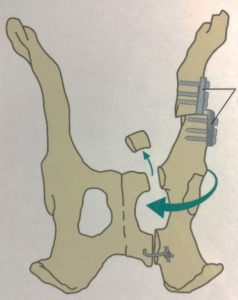Triple Pelvic Osteotomy
Description

A triple pelvic osteotomy is a procedure that involves making three osteotomies of the pelvis to allow rotation of the pelvis in order to create better coverage and greater contact for the femoral head within the acetabulum (hip socket).
Indications
TPO is used to treat young dogs with evidence of hip dysplasia, including hip subluxation and laxity. This procedure must be performed in young dogs, prior to the development of any radiographically visible degenerative changes in the hip. The ideal age for TPO is generally considered to be 6-12 months of age, but older dogs are occasionally candidates for a TPO. In addition to age, the severity of the hip dysplasia determines a dog’s suitability for this procedure. Dogs with severe luxation or malformation of the femoral head or acetabulum may not be good candidates regardless of age.
Postoperative Care
Pain medication is generally only required for the first 10-14 days following surgery. Give pain medication only as prescribed and do not give human drugs without first consulting with a veterinarian.
The bones are soft in young dogs and vigorous activity could lead to the screws pulling out and misalignment of the bones. Activity must be absolutely restricted to a crate or kennel with good footing. Exercise should be limited to short walks with a leash and towel support for at least 6 weeks postoperatively. Do not allow running, jumping, or playing with other pets.
Please schedule an appointment for suture removal 7 to 10 days after surgery. Another examination is recommended approximately one month postoperatively to assess healing of the pelvis. Please contact us immediately if swelling or discharge is noted from the incisions or if an increase in lameness is noted.
Prognosis
If patients are selected carefully, the prognosis for significantly improved function and quality of life following TPO is excellent. Some degree of arthritis can still develop later in life, but in most cases it is not severe enough to require further treatment. Potential complications following TPO include implant failure if exercise restriction is not enforced, infection, and rarely, sciatic nerve damage.
Your pet’s recovery and well-being are our primary concerns, so please do not hesitate to call and speak with a surgical technician or surgeon if there are any questions regarding your pet’s recovery.
Figure 1: Rodríguez Gómez, J., Gragera Artal, J., Nuviala Ortín, J., & Marco Cámara, V. (2014). Pet owner educational atlas.Illustration 10.11
